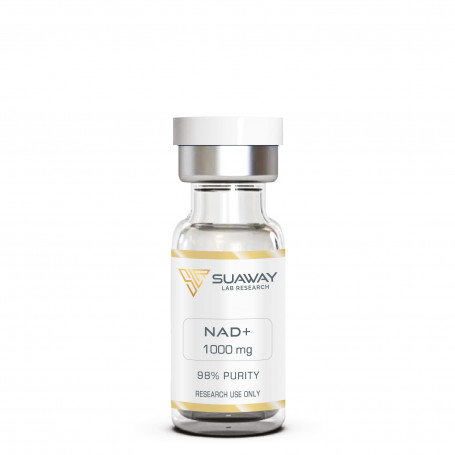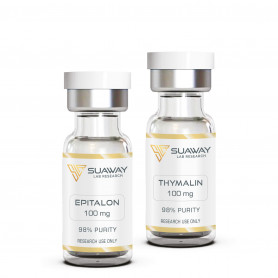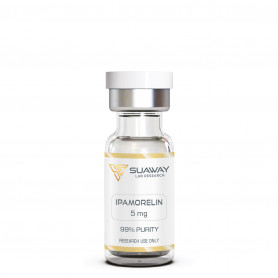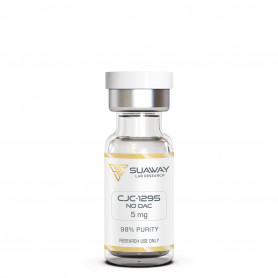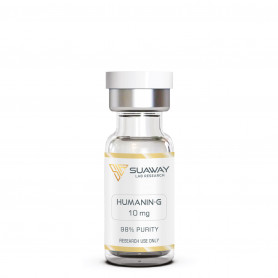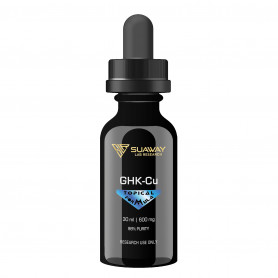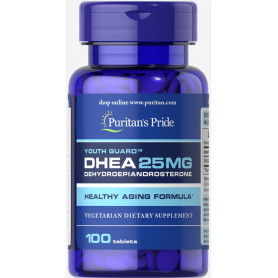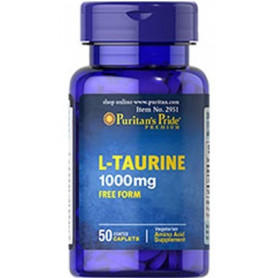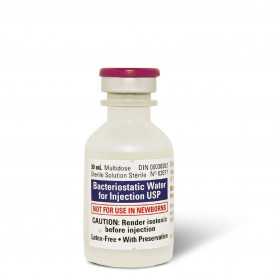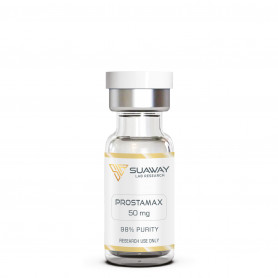NAD+ - 1000mg
NAD+ (nicotinamide adenine dinucleotide) is a coenzyme found in all living cells that plays a crucial role in cellular metabolism. It is involved in a wide range of biological processes, including energy production, DNA repair, and cell signaling. NAD+ levels can decline with age and are also affected by factors such as diet and lifestyle. Research has shown that enhancement of NAD+ may have potential benefits for various health conditions, including neurodegenerative diseases, type 2 diabetes, and addiction
Description
STRUCTURE
NAD+ LYOPHILIZED
Molecular Formula: C21H27N7O14P2
Molecular Weight: 663.43 g/mol
CAS number: 53-84-9
Peptide purity: greater than 98%
Other details: No TFA Salt, No Mannitol
Storage: -20° C
DESCRIPTION
NAD+, which stands for nicotinamide adenine dinucleotide, serves as the oxidized form of NADH and acts as a vital support molecule within a cell. Its main function involves carrying electrons between biochemical reactions to transfer energy, and it can also activate or deactivate enzymes, modify proteins post-translationally, and facilitate cell-to-cell communication. As an extracellular signaling molecule, NAD+ has been observed to be secreted by neurons in various areas, including blood vessels, the bladder, the large intestine, and specific neurons in the brain.
NAD+ has numerous effects, including those related to cellular metabolism and extracellular signaling, and research has demonstrated its importance in various functions such as energy conversion, DNA repair, immune defense, and circadian rhythms. However, NAD+ levels are sensitive to disease and age-related declines. The following are some of the effects that NAD+ has that decrease as a result of natural aging-induced drops in its levels:
• NAD+ activates sirtuins and Poly-ADP-ribose polymerases, which are enzymes that participate in DNA repair and inflammatory processes. Sirtuins are also responsible for the lifespan-extending benefits of calorie restriction.
• NAD+ regulates the production of the protein PGC-1-alpha, which safeguards neurons and other central nervous system cells against oxidative stress. Research in mice suggests that this particular effect may be related to enhanced memory, especially in aging individuals.
• In mouse models, NAD+ helps to guard blood vessels against age-related calcification and the accumulation of atherosclerotic plaques. In some studies, the cofactor has even been demonstrated to reverse age-related aortic dysfunction.
• Mice given NAD+ have exhibited increased metabolic rates and enhanced lean body mass.
• Older mice treated with NAD+ have demonstrated improved muscle strength and endurance.
• NAD+ has been found to be associated with extracellular signaling, especially for smooth muscle, and may be beneficial in gastrointestinal function. This effect is likely accountable for NAD+'s blood pressure-related benefits.
The decline in both the quality and activity of mitochondria is one of the primary outcomes of the standard aging process. Mitochondria, which produce energy for various bodily functions such as neuron firing, digestion, and muscle function, have been associated with normal aging and several age-related diseases. Research has indicated that mitochondrial aging contributes to cellular senescence, inflammation, and changes in stem cell activity, all of which make it harder for the body to recover from injury in old age.
Mitochondria, according to Nuo Sun of the Heart, Lung, and Blood Institute of the National Institutes of Health, cannot be viewed solely as bioenergetics factories. Instead, they function as platforms for intracellular signaling, regulators of innate immunity, and modulators of stem cell activity. Sun explains that mitochondria are linked to a wide range of aging processes, including senescence, inflammation, and age-dependent decline in tissue and organ function. In other words, the protection of mitochondrial function is the first step in understanding how to slow down, halt, or even reverse the aging process.
New research indicates that some of the age-related decline observed in mitochondria can be reversed through dietary supplementation with NAD+. David Sinclair of Harvard University, who discovered the anti-aging effects of reservatrol, also made popular the function of NAD+ in research circles. In 2013, Sinclair revealed that the injection of a precursor to NAD+ could restore mitochondria in the muscle of mice to a more youthful state.
In 2013, research demonstrated that decreased levels of NAD+ cause cells to enter a pseudohypoxic state, which disrupts the regular communication between the nucleus and the mitochondria. However, when old mice are supplemented with NAD+, mitochondrial function is restored and communication resumes.
NAD+ is thought to offset the effects of aging in part because it activates SIRT 1 function in the nucleus, preventing the typical age-related decrease in expression of this specific gene. SIRT 1 is a gene that codes for a protein called sirtuin 1, which is an enzyme that regulates proteins involved in cellular metabolism and processes linked to stress, longevity, and inflammation.
Muscle function is another area where the link between NAD+ and aging is apparent. In mouse models, age-related muscle decline occurs in two phases. During phase 1, oxidative phosphorylation, the process by which mitochondria produce energy, declines due to reduced expression of mitochondrial genes. In phase 2, genes that regulate oxidative phosphorylation begin to malfunction in both the mitochondria and nucleus. However, phase 1 is reversible with NAD+ administration. Studies have shown that mice receiving NAD+ exhibit improved mitochondrial function and do not progress to phase 2. However, if the mice are not intervened with NAD+ and are allowed to progress to phase 2, then NAD+ cannot rescue them. This evidence suggests that early supplementation with NAD+ is critical to fighting off aging in the long term. Additionally, research shows that exercise training has the same effect on aging mitochondria as NAD+ supplementation. Both interventions help prevent changes in peroxisome proliferator-activated receptor gamma co-activator 1-alpha (PGC-1-alpha) signaling that lead to mitochondrial dysfunction. Studies in mouse models of skeletal muscle aging suggest that exercise training helps maintain muscle oxidative capacity over a lifetime by increasing PGC-1-alpha levels, which in turn protects mitochondrial DNA, oxidative proteins, and angiogenic proteins.
The knowledge gained about NAD+ and aging is relevant to several disease conditions, particularly those affecting the central nervous system, such as Alzheimer’s and Huntington’s diseases. A 2019 review article provided an overview of current knowledge on the relationship between NAD+ and the central nervous system. In mouse models of human diseases like Huntington’s disease, NAD+ has been found to be neuroprotective. By improving mitochondrial function, it reduces the production of reactive oxygen species (ROS), which can cause damage and accelerate aging. There is potential for a synergistic effect from combining NAD+ supplementation with PARP inhibitors, a class of medications involved in DNA repair and programmed cell death. Although activated PARP is important for DNA repair, excessive PARP activity can deplete cellular energy stores and induce programmed cell death.
By supplementing NAD+, mouse models of Parkinson’s disease have shown protection against motor deficits and dopaminergic neuron death in the substantia nigra. This finding indicates that NAD+ could potentially slow or even prevent the development of Parkinson’s disease, rather than only improving symptoms.
Additionally, research has revealed that NAD+ supplementation may help prevent disease by inhibiting the breakdown of neurotransmitters and reducing the need for protein precursors to produce NAD+. Tryptophan, an essential amino acid and building block of neurotransmitters and proteins, is broken down by the kynurenine pathway (KP) to produce NAD+. This process leads to direct competition between the production of NAD+ and essential neurotransmitters. KP imbalances have been linked to neurodegenerative conditions such as Alzheimer's, Huntington's, and Parkinson’s disease, as well as psychiatric disorders like schizophrenia and bipolar disorder. Ongoing research is investigating whether NAD+ supplementation can prevent KP imbalances and, thus, ameliorate or prevent these neurodegenerative conditions.
The role of NAD+ in reducing inflammation is affected by several factors, including NAMPT, an enzyme known to be associated with inflammation and often overexpressed in certain types of cancer. NAMPT is also linked to the development of obesity, type 2 diabetes, and nonalcoholic fatty liver disease, and its activation leads to inflammation as NAD+ levels decrease. To combat this, researchers are investigating the potential of targeting NAMPT as an anti-cancer treatment and using NAD+ supplementation to reduce its activation and modulate inflammation.
The NAD+/NAMPT dichotomy is believed to be a primary driver of insulin resistance, which is associated with obesity and often leads to type 2 diabetes and heart disease. Obesity triggers inflammation, which decreases NAD+ levels, increases free fatty acid levels in the blood, and down-regulates adiponectin. This leads to the liver producing more glucose while interfering with the insulin-mediated uptake of glucose by skeletal muscle, resulting in insulin resistance. The pancreas produces more insulin to overcome this resistance, leading to high glucose levels and diabetes over time.
The negative impact of drugs and alcohol on NAD+ levels has been widely recognized for a long time. This phenomenon results in nutritional deficiencies and is associated with changes in mood and cognition. NAD+ supplementation as a means to counteract these deficits was first introduced in the 1960s. However, recent studies have shown that combining NAD+ with specific amino acid complexes can have a significant impact on addiction recovery and lead to more enduring outcomes. Studies suggest that this combination can decrease cravings, alleviate stress and anxiety, and improve overall well-being during addiction rehabilitation.
Animal models have provided compelling evidence that NAD+ supplementation can mitigate the effects of mitochondrial aging, but further research is needed in human clinical trials. The potential of NAD+ as a treatment for neurodegenerative diseases and chronic type 2 diabetes is being actively investigated, with promising results suggesting that NAD+ can slow the progression of these conditions. Moreover, there is hope that NAD+ alone or in combination with other therapies could potentially reverse certain disease processes or even modulate the aging process. NAD+ supplementation may represent an exciting avenue for future aging research.
REFERENCES
N. Braidy et al., "NAD+ therapy in age-related degenerative disorders: A benefit/risk analysis" [PubMed]
A.J. Covarrubias et al., "NAD+ metabolism and its roles in cellular processes during ageing" [PubMed]
L.E. Navas et al., "NAD+ metabolism, stemness, the immune response, and cancer" [PubMed]
J.M. Campbell "Supplementation with NAD+ and Its Precursors to Prevent Cognitive Decline across Disease Contexts" [PubMed]
M. Abdellatif et al., "NAD+ Metabolism in Cardiac Health, Aging, and Disease" [PubMed]
N.J. Conlon "The Role of NAD+ in Regenerative Medicine" [PubMed]
R. Zapata-Pérez et al., "NAD+ homeostasis in human health and disease" [PubMed]
DISCLAIMER
This product is intendend for lab research and development use only. These studies are performed outside of the body. This product is not medicines or drugs and has not been approved by the FDA or EMA to prevent, treat or cure any medical condition, ailment or disease. Bodily introduction of any kind into humans or animals is strictly forbidden by law. This product should only be handled by licensed, qualified professionals.
All product information provided on this website is for informational and educational purposes only.

